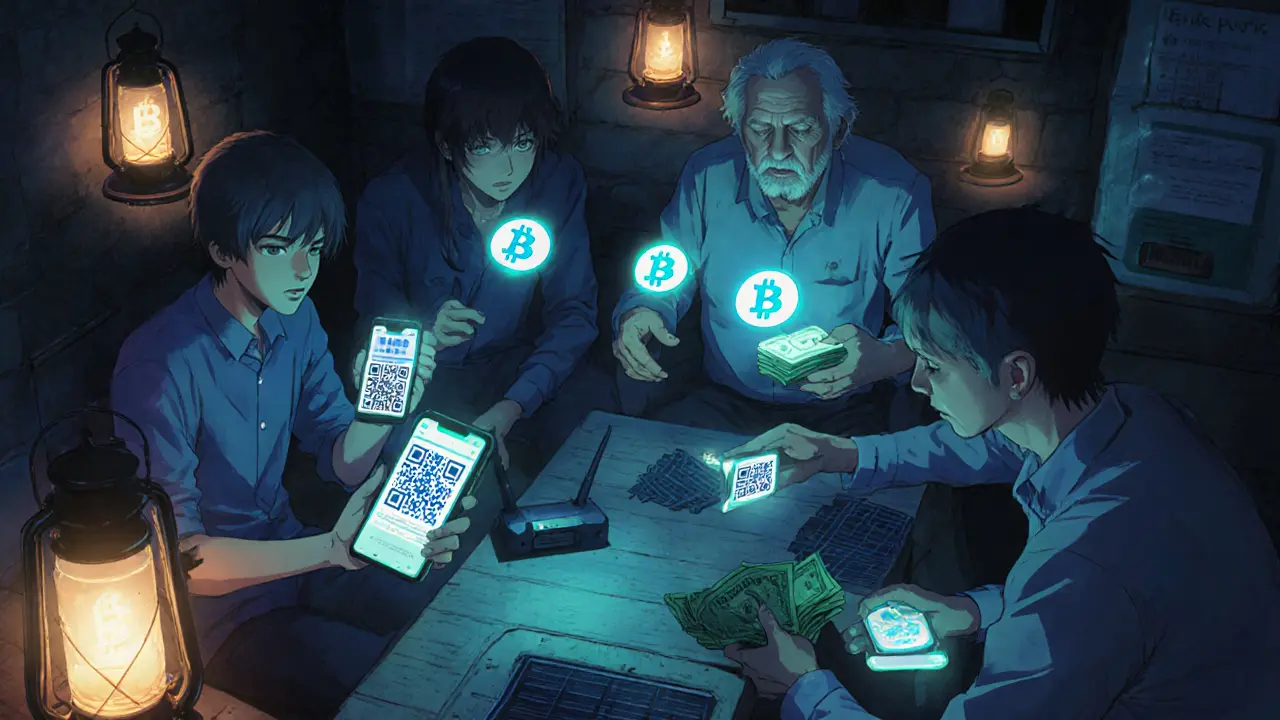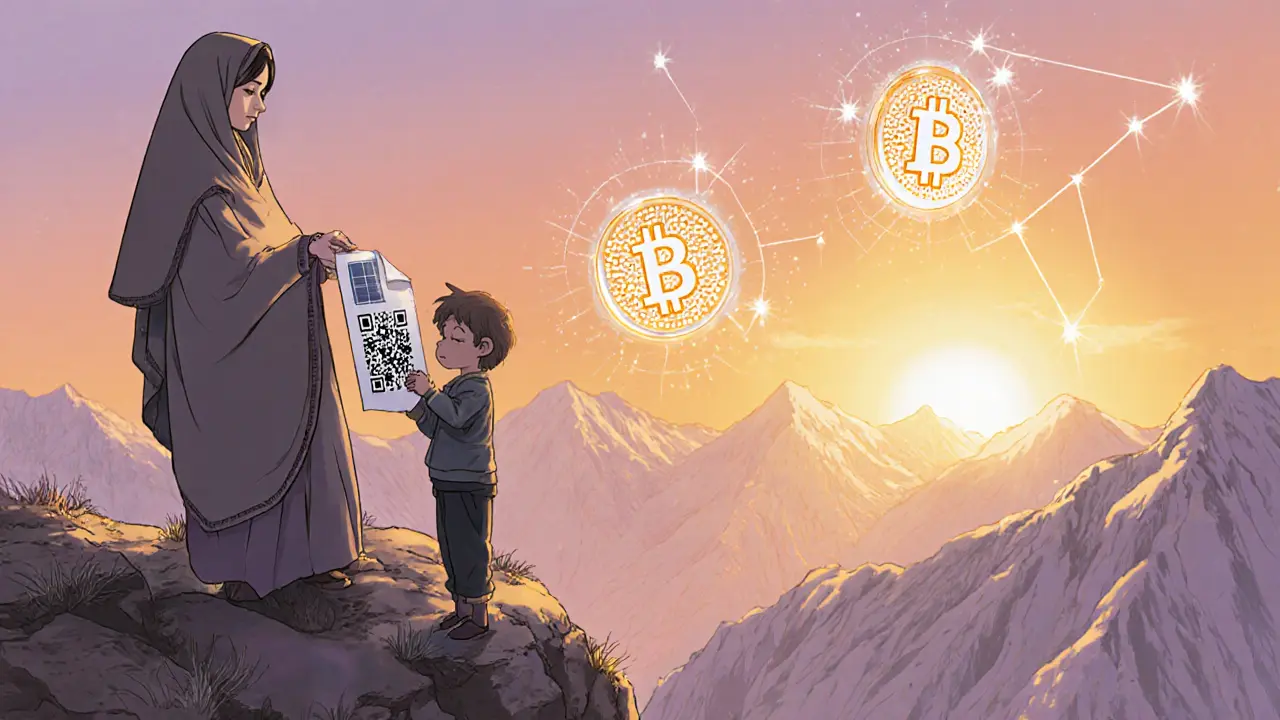Afghanistan’s Underground Crypto Trade Under Taliban Rule

Afghanistan Crypto Trading Risk Calculator
Estimated Risk Level
When the Taliban seized power in August 2021, they didn’t just change the political map - they shattered the country’s banking system and declared every form of cryptocurrency haram, or forbidden under Islamic law. Yet, by 2025 a silent network of traders still moves Bitcoin, USDT and other digital assets across the rugged terrain of Afghanistan. This covert economy has become a lifeline for millions who can’t rely on banks, but it also puts users at constant risk of raids, internet blackouts and harsh religious rulings.
Why the Taliban banned crypto in the first place
The ban stems from a strict Sharia law interpretation that views speculative trading without tangible backing as gambling, which is prohibited. In August 2022 the regime officially revoked all crypto exchange licenses, ordered the shutdown of mining rigs, and began arresting a handful of early adopters. The statement from the Supreme Leader framed the move as protecting the nation’s moral fabric, not merely a financial decision.
How the underground market survived
Despite the crackdown, a resilient underground cryptocurrency trading ecosystem sprang up. The core mechanics are simple: Afghans receive crypto from relatives abroad, convert it peer‑to‑peer (P2P) on encrypted messaging apps, and use the proceeds to buy hard cash or pay for goods. Two digital currencies dominate:
- Bitcoin - the most widely accepted, especially for larger remittances.
- USDT (Tether) - favoured for its price stability when paying everyday vendors.
Local apps like HesabPay initially offered a clean mobile‑to‑mobile transfer experience, racking up 380,000 users in three months. After the August 2022 ban, HesabPay’s public interface was taken offline, but its codebase lives on in encrypted group chats that act as informal escrow services.
Enforcement realities and loopholes
Taliban enforcement is a mix of sporadic raids and sweeping internet restrictions. In late 2022 recorded transaction volumes fell to roughly $80,000 per month - a sharp drop from the pre‑ban surge. Yet the decentralized nature of crypto makes a total wipe‑out impossible. The regime’s biggest tool is the internet blackout: by September 2024, connectivity in provinces like Kunduz and Badakhshan fell below 1% of normal levels, severely hampering online verification and real‑time price updates.
Because only about 8.6million Afghans have reliable internet, many traders have shifted to low‑bandwidth solutions: SMS‑based order books, radio‑transmitted QR codes, and even offline mesh networks that let phones talk to each other without a central ISP.

Economic lifeline for a poverty‑stricken nation
The United Nations warned that 97% of Afghans could slip below the poverty line in 2022 - a figure that rose sharply after sanctions froze foreign reserves. In that vacuum, crypto remittances surged 80% immediately after the Taliban takeover. For a typical family receiving $300 a month from a relative in the Gulf, that money can buy food, medicine and school fees that would otherwise be unaffordable.
Forex dealers have quietly become the middlemen, converting crypto into hard cash at a premium. This creates a parallel market where a single Bitcoin can fetch anywhere between $28,000 and $33,000 in the hands of a local dealer, depending on risk appetite and the current internet situation.
Technological constraints and adaptation
Power cuts, illiteracy and the lack of a robust telecom backbone are constant hurdles. Traders often rely on solar‑charged phones and portable generators to keep their devices online during blackouts. Educational workshops-sometimes run in secret basements-teach basic digital‑wallet usage, even though participation can lead to imprisonment.
Because official VPN services are blocked, many users resort to proxy chains and Tor bridges hosted on servers outside Afghanistan. The Taliban’s recent crackdown on “vice” includes seizing personal routers that are suspected of facilitating crypto traffic.
Humanitarian and political implications
Beyond the numbers, underground crypto trading is a form of quiet resistance. When women in Kabul are barred from formal education, some join P2P networks to earn money selling handmade goods, receiving payments in USDT. The very act of moving money outside the state’s control challenges the regime’s claim to total authority.
International aid agencies have taken note. Some NGOs now accept crypto donations and funnel them through trusted local operators, bypassing frozen bank accounts. However, the lack of regulatory oversight also means scams are rife -fraudulent “exchange” groups can disappear with funds, leaving victims with no legal recourse.
Future outlook: Will the underground survive?
Three forces will shape the next few years:
- Taliban digital control - Continued internet blackouts could push traders toward fully offline solutions, like QR‑coded paper vouchers that can be redeemed later.
- International sanctions - If sanctions ease, traditional banking may re‑emerge, reducing crypto demand.
- Technological innovation - Emerging mesh‑network protocols could enable secure, low‑power crypto transfers without relying on ISP infrastructure.
Until a stable banking system returns or the regime relaxes its religious rulings, the underground market will likely persist, evolving its methods to stay one step ahead of the authorities.
| Aspect | Legal (pre‑2022) | Underground (2022‑2025) |
|---|---|---|
| Legality | Allowed under informal regulation | Declared haram, prohibited |
| Accessibility | City banks, licensed exchanges | P2P chats, encrypted apps, mesh networks |
| Main platforms | HesabPay, local exchanges | Telegram groups, WhatsApp, SMS order books |
| Risk level | Low - regulated | High - raids, arrests, scams |
| Primary currencies | Bitcoin, USDT, local fiat | Bitcoin, USDT, informal hard‑cash conversion |

Frequently Asked Questions
Is crypto really illegal in Afghanistan?
Yes. Since August2022 the Taliban has declared all cryptocurrency trading, mining and usage haram under their interpretation of Sharia law. The ban is enforced through arrests and periodic internet shutdowns.
How do Afghans still move crypto despite the ban?
Most transactions happen peer‑to‑peer via encrypted messaging apps, SMS order books, or low‑bandwidth mesh networks. Traders act as informal escrow agents, and many use Bitcoin or USDT because they can be transferred with just a phone number.
What role do foreign remittances play?
Crypto is now the fastest way for Afghans abroad to send money home. After the Taliban’s takeover, crypto‑based transfers rose about 80% in the first months, providing essential cash for food, medicine and education.
Can internet blackouts stop underground trading?
Blackouts make real‑time price checks harder, but traders have adapted with offline QR codes, SMS‑based order books and mesh networks. So while activity slows, it doesn’t halt.
What are the biggest risks for participants?
Risks include arrest by Taliban forces, loss of funds to scams, and volatile exchange rates when converting to hard cash. There’s also the danger of power outages cutting off access to wallets at critical moments.
Shelley Arenson
Thanks for sharing! 😊
Joel Poncz
i really feel terrible for the folks tryin to survive under the Taliban, especially when they gotta risk their safety just to trade crypto.
it’s wild how the underground market is still hustlin despite the bans.
people are just tryin to make a living, not cause trouble.
stay safe and keep supporting each other.
Kris Roberts
The paradox of underground crypto in Afghanistan is fascinating.
On one hand, the Taliban's strict rules push traders into secrecy; on the other, the relentless human drive for financial autonomy fuels covert networks.
This tension reveals a deeper yearning for economic freedom that transcends political oppression.
When people resort to encrypted apps and hidden exchanges, it's not just about profit, it's about reclaiming agency.
History shows that such underground economies often become catalysts for broader societal change.
lalit g
I think it’s important we look at this situation with empathy and an open mind.
People are forced into risky behavior because of limited options.
Let’s hope the international community can find ways to support safe financial avenues.
Reid Priddy
Sure, the Taliban let everyone have a crypto playground, just as long as you don’t see the dark side of it.
Everything’s fine as long as the puppeteers stay invisible.
Shamalama Dee
It’s inspiring to see communities adapting to such restrictive environments while maintaining safety standards.
Education on encryption and risk mitigation is crucial for protecting participants.
Let’s continue to share best practices and resources.
scott bell
Crypto in the shadows feels like a secret club
you never know who’s watching but you keep going
the thrill is almost poetic
vincent gaytano
Oh great, another underground market – just what we needed to keep the drama alive.
Because nothing says ‘secure’ like a hidden ledger.
Dyeshanae Navarro
People are trying to survive, simple as that.
Doing crypto in secret is risky but sometimes necessary.
We should understand the human side of this.
Hope there’s a better future.
roshan nair
Let me break this down step by step for anyone who might be confused about how the underground crypto trade works under the Taliban's watchful eye.
First, the Taliban prohibits most forms of digital currency, but they have no real technical capacity to monitor every encrypted transaction, which creates a paradoxical safe‑haven for savvy traders.
Second, people rely heavily on VPNs and proxy servers to mask IP addresses, often using mobile data connections that are less likely to be intercepted.
Third, the most common platforms are Telegram and Signal, because they offer end‑to‑end encryption and are widely available even in low‑bandwidth environments.
Fourth, local “brokers” act as intermediaries, collecting fiat from users and converting it to crypto, usually charging a 2‑5 % fee for the service.
Fifth, the risk of sudden raids is real; anyone caught can face severe penalties, so the community has developed a code of silence and trust networks akin to traditional black markets.
Sixth, the price spreads can be volatile due to limited liquidity, often leading to arbitrage opportunities for those who can move quickly between markets.
Seventh, there’s a growing awareness campaign among traders about phishing attacks, because scammers prey on the same anonymity to steal funds.
Eighth, education on best practices is spread through YouTube tutorials in Pashto and Dari, emphasizing the importance of hardware wallets.
Ninth, the use of hardware wallets adds an extra layer of security, though many cannot afford them, relying instead on software wallets with strong passwords.
Tenth, the community occasionally collaborates with diaspora groups in Europe and North America to funnel larger sums through regulated exchanges, bypassing local restrictions.
Eleventh, this transnational link creates a feedback loop where international crypto prices influence local trading strategies.
Twelfth, the humanitarian impact is notable – some families use crypto to pay for medical supplies that are otherwise unavailable.
Thirteenth, the government’s lack of clear policy means the legal gray zone persists, making it difficult for NGOs to provide targeted aid.
Fourteenth, there’s a psychological toll on traders who must constantly live in fear of discovery, leading to stress and anxiety.
Fifteenth, supporters argue that this underground ecosystem is a form of resistance, a way for citizens to assert financial sovereignty.
Sixteenth, critics say it fuels an unregulated market that can be exploited by criminal elements.
Seventeenth, the balance between empowerment and risk continues to tip as technology evolves and the Taliban may eventually adapt their enforcement tactics.
Eighteenth, for anyone considering participation, the safest route remains to stay informed, use strong encryption, and limit exposure to any single platform.
Nineteenth, remember that any transaction carries inherent risk, especially in a volatile geopolitical context.
Twentieth, staying connected with trusted peers and seeking advice from experienced users can make a significant difference in navigating these challenges responsibly.
Jay K
I appreciate the thorough analysis provided earlier; the emphasis on hardware wallets and community education is particularly salient.
Ensuring that users adopt strong security practices can mitigate many of the outlined risks.
Kimberly M
Thank you for the concise overview! 😊
Navneet kaur
Well, if you think using Telegram is safe, you probably also believe the sky is pink.
Think again.
Marketta Hawkins
Another hidden market? This is getting out of hand… 😒
Drizzy Drake
Man, the resilience of these traders is just mind‑blowing. They’re juggling encrypted apps, dodge Taliban edicts, and still manage to keep the crypto wheels turning.
What’s wild is how they adapt with limited internet, hopping between full‑coverage spots and blackout zones just to get a few minutes online.
And the fact that they’re doing all this while trying to stay safe – using hardware wallets, VPNs, and a network of trusted brokers – shows real ingenuity.
It reminds me of those old underground economies where cash changed hands under the table, but now it’s digital and even more complex.
Hopefully, with more education and perhaps some international support, they can lower the risk and make it a bit less of a nerve‑racking hustle.
AJAY KUMAR
Those philosophical musings about crypto freedom are just another form of digital propaganda.
The reality is that endless talks won’t change the fact that people are forced into dangerous shadows.
bob newman
Oh sure, because the Taliban just loves a good Bitcoin party.
Everyone's having a blast, right?